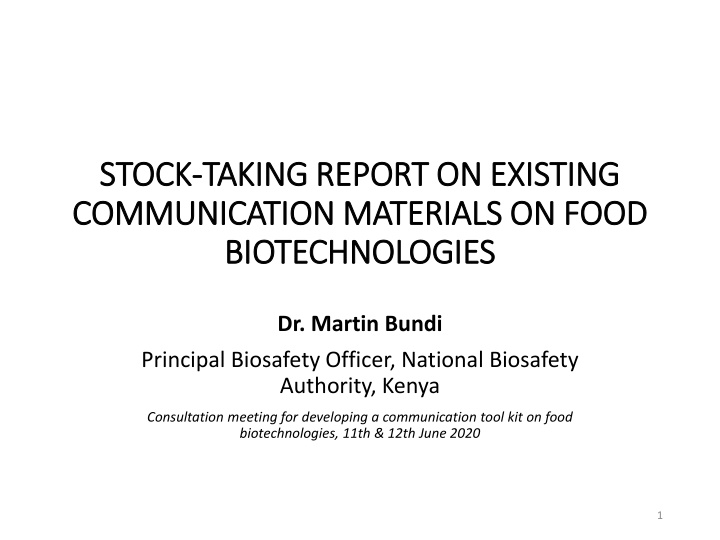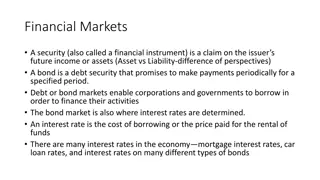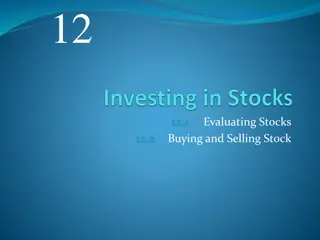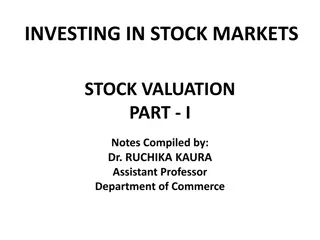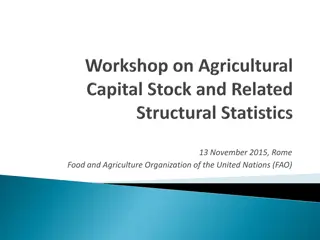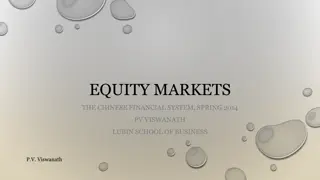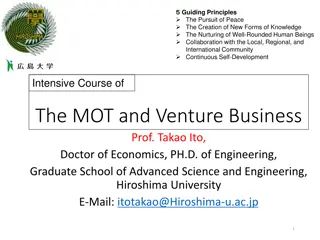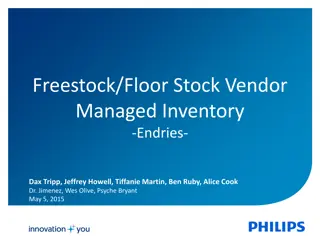Stock-taking Report on Existing Communication Materials on Food Biotechnologies
Stock-taking analysis of existing communication materials conducted by NBA and FAO on food biotechnologies. A total of 222 materials were gathered covering topics such as government interaction, public communications, basic facts, uses and benefits, expert views, and regulatory framework. Materials were sourced from 50 countries across different Codex regions, highlighting key areas of existing gaps in communication about food biotechnologies. Analysis of the results showed varying levels of coverage on different topics, with regulations, genetically modified organisms, and uses and potential benefits being the most frequently discussed keywords.
Download Presentation

Please find below an Image/Link to download the presentation.
The content on the website is provided AS IS for your information and personal use only. It may not be sold, licensed, or shared on other websites without obtaining consent from the author.If you encounter any issues during the download, it is possible that the publisher has removed the file from their server.
You are allowed to download the files provided on this website for personal or commercial use, subject to the condition that they are used lawfully. All files are the property of their respective owners.
The content on the website is provided AS IS for your information and personal use only. It may not be sold, licensed, or shared on other websites without obtaining consent from the author.
E N D
Presentation Transcript
STOCK STOCK- -TAKING REPORT ON EXISTING TAKING REPORT ON EXISTING COMMUNICATION MATERIALS ON FOOD COMMUNICATION MATERIALS ON FOOD BIOTECHNOLOGIES BIOTECHNOLOGIES Dr. Martin Bundi Principal Biosafety Officer, National Biosafety Authority, Kenya Consultation meeting for developing a communication tool kit on food biotechnologies, 11th & 12th June 2020 1
Stock-taking analysis of existing communication materials NBA and FAO conducted a review of existing food biotechnologies communication materials (both online and those shared by FAO food safety platform focal points) A total of 222 communication materials were gathered falling in the following six topics: 1) Government interaction with stakeholders 2) Public communications 3) Basic facts on food biotechnologies 4) Uses and benefits 5) Expert views and opinions 6) Regulatory framework on the food biotechnologies 2
Continuation. Materials were obtained from 50 countries from the 6 Codex regions 102 materials through online searches (17 countries) 120 materials sent by Platform Focal Points in 33 countries (below table) Codex region CCAFRICA (7) Platform community members Ethiopia, Kenya, South Africa, Swaziland, Uganda, Zambia, Zimbabwe Bangladesh, Bhutan, Malaysia, Philippines, Singapore, Sri Lanka, Thailand Belgium, Bosnia and Herzegovina, European Union, Ireland, Latvia, Luxembourg, Norway, Sweden, UK CCASIA (7) CCEURO (9) CCLAC (2) CCNASWAP (4) CCNEA (4) Argentina, Grenada Australia, Canada, New Zealand, United States of America Iran, Lebanon, Sudan, United Arab Emirates 3
Analysis of results 1. Analysis of materials by topic highlighting areas of existing gaps in communications about food biotechnologies Number of materials by topic (2) Public communications 81 (6) Regulatory framework 80 (3) Basic facts 58 (4) Uses and benefits 46 (1) Stakeholders interactions 43 (5) Expert s views 28 0 10 20 30 40 50 60 70 80 90 4
Continuation. Most frequently used key words Regulations (96) Genetically modified (79) Uses and potential benefits (69) Basic facts (48) Concerns by consumers (45) Least frequently used key words Nutrition (3) Tissue culture (1) Private sector and industry associations (1) Media (1) Interviews (1) 5
2. Producers of the communication materials Number of materials by producer 0% Government 3% 8% NGO 1% 10% Research institute 11% Private sector International organization 67% Media Other 6
Continuation. Collected materials by country 25 23 20 16 14 15 1212 11 10 8 8 7 7 6 6 6 6 5 5 5 5 5 5 4 4 5 3 3 3 3 2 2 2 2 2 2 2 1 1 1 1 1 1 1 1 1 1 1 1 1 1 1 1 0 Thailand Australia Malaysia Sudan China EU Belarus Bhutan Norway Bosnia and Herzegovina Switzerland Japan Ireland Sweden Latvia Mali Nigeria Brazil Luxembourg Not applicable New Zealand Kenya Ghana Tonga Uruguay India Spain Zambia UAE Grenada Not identified Singapore UK Uganda Philippines South Africa Mexico USA Canada Swaziland Ethiopia Belgium Iran Argentina Lebanon Bangladesh Pakistan Zimbabwe Egypt CCNASWAP CCASIA CCEURO CCAFRICA CCNE CCLAC 7
3. Type of communication materials and year of publishing Number of materials by type 80 68 70 60 46 50 40 30 25 23 18 20 14 12 6 10 4 4 2 0 8
Continuation. Number of materials by year 70 58 57 60 50 40 30 26 22 20 14 12 8 7 10 6 5 2 2 1 1 1 0 9
Identified gaps and considerations Most materials largely focused on GMOs Limited materials on areas on applications and benefits, perspectives for farmers, socio-economic issues and nutrition Tool kit should cover various aspects of the food biotechnologies with the focus remaining on modern and new technologies such as gene-editing. Most materials obtained from government regulatory authorities were lengthy text-oriented materials focusing on regulatory and policy information, with limited infographics Materials in the toolkit should be less wordy and include more infographics for communication effectiveness. 10
Continuation. Many identified materials were directly sent by focal points and were not available on the Institutional websites Need for materials to be posted in governmental websites where general public can access Websites of the governmental agencies in some countries, particularly in Asia and Near East regions are available only in their native languages Need to translate the final toolkit into various local languages to facilitate better communication with their public. 11
Proposed materials for development of the example materials Considering the identified gaps, 34 communication materials were recommended for further review when developing the toolkit. Materials were produced by 15 countries from the following regions: CCAFRICA region Kenya (2), South Africa (2), Uganda (3) and Zambia (1) CCASIA region Bhutan (1), Malaysia (1) and Singapore (7) CCEURO region European Union (3), Ireland (1), Norway (1) and UK (1) CCNASWAP region Australia (2), Canada (2), New Zealand (2) and USA (5) 12
Thank you 13
